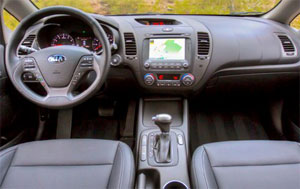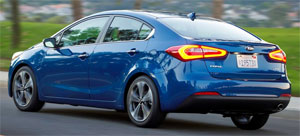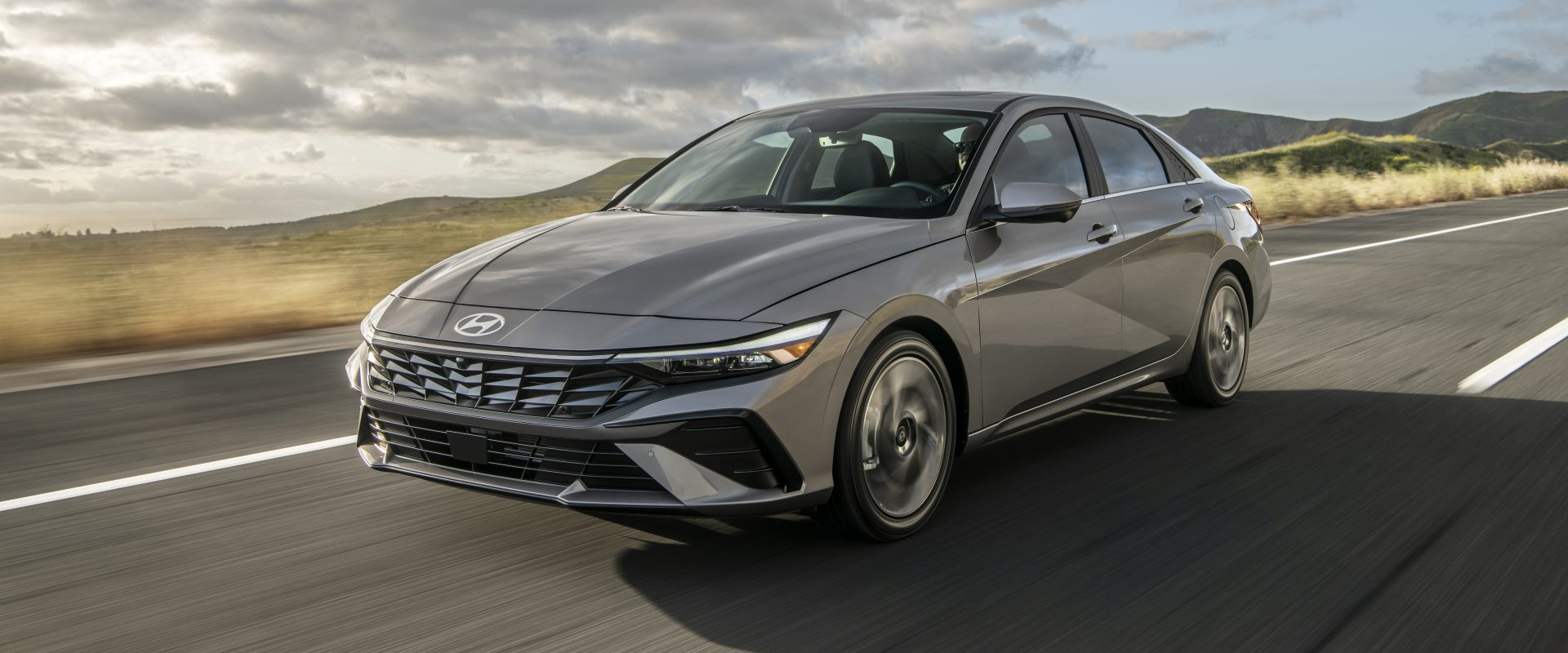2014 Kia Forte
With each new generation of their Forte compact, Kia has gotten increasingly serious about giving small car stalwarts Civic and Corolla a real run for buyer’s money. The first design was competent, while the second gen was another step in the right direction, albeit a small one. Now, Kia has stepped up their game again as a third generation Forte marches onto the scene. So let’s see if this step is another small one, or a leap?
At first glance it’s obvious that this 2014 Kia Forte sedan takes on the Euro-inspired design language of other recent Kia's…with its large multi-sided grille, and very sharp looking sheet metal when viewed against more vanilla rivals like the Honda Civic, and Nissan Sentra. Only the now quite stylish Toyota Corolla, and sister Hyundai Elantra, visually compare.
A 106.3-inch wheelbase and 179.5-inch length make Forte longer, lower, and wider than before, slotting between Civic and Sentra in size. As before, a 5-door hatchback and 2-door Koup will also be available, both featuring even more aggressive styling.
 The nicely finished interior sees a much softer makeover, with a refreshingly simple layout that still appears more expensive than it is. Front seats, despite being thin and narrow, are comfortable enough for the daily commute, if not so much for long distance work. The same goes for the rear seats where room and shape of seats is also most suited for a pair of commuters.
The nicely finished interior sees a much softer makeover, with a refreshingly simple layout that still appears more expensive than it is. Front seats, despite being thin and narrow, are comfortable enough for the daily commute, if not so much for long distance work. The same goes for the rear seats where room and shape of seats is also most suited for a pair of commuters.
Where Kia really seems to be standing out is with their UVO infotainment system, which works much better than all of their competition and even many high end luxury car systems. The touchscreen is incredibly intuitive, and all controls, including those for radio and navigation, are first class.
Speaking of class, our EX tester had the Premium and Technology Packages. They add, among other unexpected things, a heated steering wheel, heated seats, ventilated seat for the driver, push button start, dual zone climate, HID headlights, and LED tail lights.
Gauges are nice and clear, with the exception being the small digital block fuel gauge; but overall much like the rest of the interior; it’s simple, effective, and attractive. The trunk provides a good 14.9 cubic-ft. of space and the finish is surprisingly nice for a compact car. Folding rear seats make carrying long items a snap.
Two 4-cylinder engines are available, the LX’s 1.8-liter and the EX’s 2.0-liter. We suggest going with the latter and its 173-horsepower and 154 lb-ft. of torque. It feels plenty powerful for daily use, including for highway passing, which is slowed while the standard 6-speed automatic transmission hunts for a lower gear. A 6-speed manual is standard on the LX.
We took the 2.0-liter EX to the track, and despite the engine sounding like it was made my Fisher Price, all was good; though it would benefit greatly from a richer exhaust sound. Still, the 2-point-0 gets you to 60 in a class respectable 8.8-seconds, and through the ¼-mile in 16.8-seconds at 85 miles-per-hour. There is a manual shift mode for the auto, but it too is slow to respond, doesn’t help track times, and added nothing to our straight-line enjoyment.
The McPherson strut front and torsion beam rear suspension is designed more with an eye towards comfort than sporty performance. But, it equated itself well enough through our slalom course. It was surprisingly enjoyable, with only minor understeer, and an unobtrusive stability control. Steering response is agile, and Kia’s optional FlexSteer adjustable system is available to tailor the feel to your liking. Brakes were more ordinary, taking 132-feet to stop from 60 miles per hour.
 Government Fuel Economy Ratings are important for any commuter car. The 2.0-liter auto rates 24-City, 36-Highway, and 28-Combined. We easily beat the combined number, averaging 30.8 miles-per-gallon of regular while driving a diverse set of roads. The Energy Impact Score is compact car worthy at 11.8-barrels of oil consumption per year with C02 emissions of 5.2 tons.
Government Fuel Economy Ratings are important for any commuter car. The 2.0-liter auto rates 24-City, 36-Highway, and 28-Combined. We easily beat the combined number, averaging 30.8 miles-per-gallon of regular while driving a diverse set of roads. The Energy Impact Score is compact car worthy at 11.8-barrels of oil consumption per year with C02 emissions of 5.2 tons.
As with all Kia's, base price is a strong point. Indeed, at $16,700 the LX strikes a nice bargain. The EX, at $20,200 to start, a little less so.
So, to answer our query of whether this new Forte is another small step, or more of a leap, we’ll lean more to the step. Still, it’s a heck of a car, and while that may be one small step for the Forte, it’s part of the giant leap that the Kia brand has made in recent years. In just about every car segment, Kia now has a very viable model that competes on much more than just price alone.
Specifications
- Engine: 2.0-liter
- Horsepower: 173
- Torque: 154 lb-ft.
- 0-60 mph: 8.8 seconds
- 1/4 mile: 16.8 seconds @ 85 mph
- EPA: 24 mpg city/ 36 mpg highway
- Energy Impact: 11.8 barrels of oil/yr
- CO2 Emissions: 5.2 tons
2024 Hyundai Elantra
Basic Transportation At Its Best…And That Is A Compliment
For those of you who write in every week bemoaning the fact that all we seem to do around here is test incredibly expensive cars and EVs that only the very well to do can afford, this one’s for you. It’s a commuter and budget friendly mainstay from Hyundai, the compact Elantra sedan. And, it has been nicely updated for 2024.
We clearly do enjoy driving high-performance machines and ultra-luxury rides around here, but like most of you, when it comes time to drive home at the end of a long workday, we do so in something much more practical and affordable, like this 2024 Hyundai Elantra sedan.
If you’re thinking the front end has gotten more aggressive, you’re right. Hyundai calls it a “Shark Nose” theme, and we’re guessing they were thinking more Great White than Hammerhead, though Megamouth shark would also apply. It helps for a low and wide look; more substantial than the typical compact. Other additions for ’24 include slimmer daytime running lights, revised stainless steel Hyundai emblem, reshaped front fenders, sport sedan-style rear diffuser with silver trim; a parametric pattern added to the C-Pillar, and new LED taillights that take up a lot more space on the highly sculpted decklid. Plus, new wheel designs in sizes ranging from 15- to 18-inches.
Standard engine in SE, SEL, and Limited grades is this naturally aspirated 2.0-liter I4 with 147 horsepower and 132 lb-ft of torque. Even with no hybrid assistance, it gets substantial Government Fuel Economy Ratings of 31 City, 40 Highway, and 34 Combined; we averaged a great 38.6 mpg of Regular.
Those high fuel economy numbers mean acceleration times are pretty high as well. It was in no particular hurry to get off the line at our test track, as after a slight jolt of power, it felt pretty sluggish going down the track, taking us a lengthy 9.4 seconds to hit 60 mph. Hyundai’s Intelligent Variable Transmission has some realistic simulated gear shifts built in, and they not only provided the feel of a true automatic, but kept engine noise from becoming overbearing. And while this 2.0-liter may not be a house-on-fire off the line, it has no problem keeping up with traffic, and feels like just the perfect amount of power for a practical and safe commuter car.
There are other engine options too. Two choices if you want to go faster, a 1.6-liter turbo with 201 horsepower in the Elantra N Line, and a 276-horsepower turbocharged 2.0-liter for the Elantra N; plus, one with even better fuel economy, a 1.6-liter hybrid with a 139 horsepower total output.
And despite some significant understeer, there was good feel through the cones of our handling course, both in steering and chassis feedback. We wouldn’t quite call it “point and shoot,” but it responded to inputs fairly quickly, with only moderate body roll. All-in-all, when it comes to performance, it doesn’t claim to bring a whole lot to the table, but does clearly overachieve with what it does bring.
And Hyundai is always overachieving when it comes to packing in features, yet has found a way of keeping things refreshingly simple with a good mix of touchscreen and manual controls. Lots of space too, both up front in the surprisingly wide front buckets, and in the rear bench with ample room for three. Updates for all Elantra interiors include softer materials on the door panels, upgraded instrumentation and additional charging ports, plus a surround view monitor and new H-Tex simulated leather for Limited trim.
Elantra pricing starts with an SE at $22,775, the SEL comes in at $24,725, Limited begins at $28,215, and the sporty N Line starts at $29,615. If you’re interested in the hybrid, base Blue starts at $27,400 with Limited at $30,600.
Some might say there’s not a whole lot that’s earth shaking about the 2024 Hyundai Elantra, but that’s mostly why we like it so much. When it comes to just delivering good, basic transportation with a high dose of unexpected amenities, Hyundai delivers once again.
Specifications
- Engine: 2.0-liter I4
- Horsepower: 147
- 0-60 mph: 9.4 seconds
- 60-0 Braking: 111 ft (avg)
- MW Fuel Economy: 38.6 MPG (Regular)
- Transmission: IVT
- Torque: 132 lb-ft
- 1/4 Mile: N/A (Track Maintenance)
- EPA: 31 City / 40 Highway / 34 Combined







